Correspondence 1936: Prof. Heinz DÄHNHARDT with Döbler (Erfurt)
Description
– Wsee more pictures below! –
You are bidding on one Correspondence from 1936 between the journalist and education official Prof. Heinz Dähnhardt (1897-1968), consultant in the Reich Ministry of Education and Instruction, and Kurt Döbler, head of the adult education center in Erfurt.
Including two typewritten letters signed by Heinz Dähnhardt.
Kurt Döbler, b. 1900 too Erfurt, socio-political studies, lecturer and head of the Erfurt adult education center 1933-1937, then dismissed by the fascists, 1945-1949 city councilor in Gotha, author of numerous religious-cultural essays.
Concerns Döbler's efforts for daughters of Journalist, novelist and cultural historian Wilhelm Heinrich Riehl (1823-1897), the impoverished sisters Hedwig Riehl (1867-1947), a music teacher (who recently moved into the teachers' holiday home), and Elisabeth Riehl (1861-1937), who is in the hospital, living in Erfurt, financial help from the ministry to get.
Besides, it's about one Biography of Wilhelm Heinrich Riehl, which was written by one of the teachers at the Erfurt adult education center, Hans Herring, and for which a publisher is now being sought (probably unsuccessfully, as I cannot find it printed). WH Riehl's estate, which one of the daughters is organizing, is also mentioned.
The letters from Döbler are available in carbon copies, the letters from Dähnhardt and from the ministry in the original.
Available:
-two signed letters from Dähnhardt to Döbler (with letterhead "Reich and Prussian Ministry for Science, Education and National Education")
-a notice (A5 format) from the minister about support for Hedwig Riehl (200 RM).
For your information, I have included photos of a similar request from Döbler at the end (not part of this offer).
Condition: Letters punched on the side and usually folded. Paper slightly stained and slightly wrinkled. Please also note the pictures!
At the same time, I offer further letters regarding help for the Riehl daughters!
Pictures

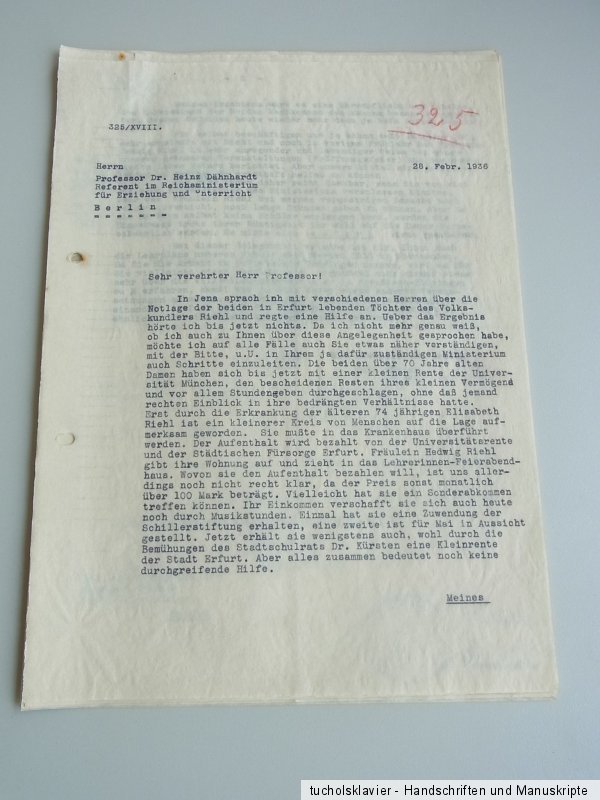
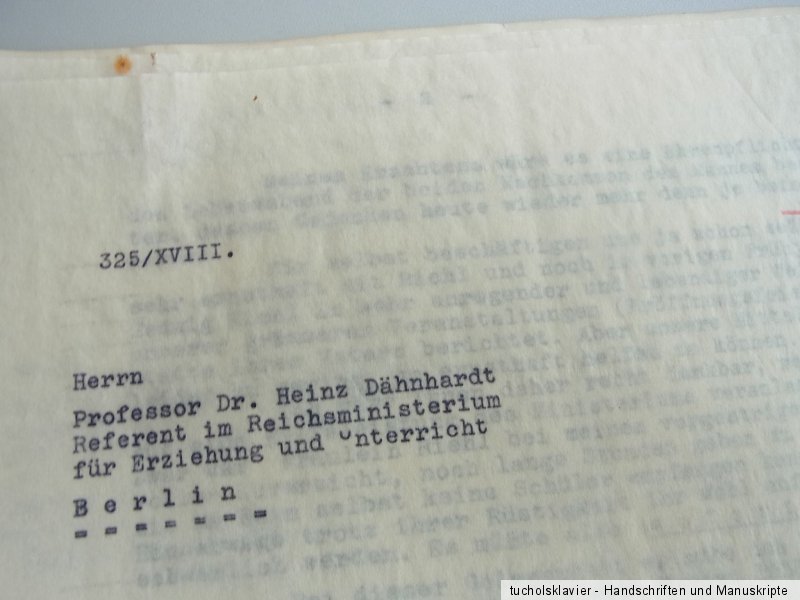

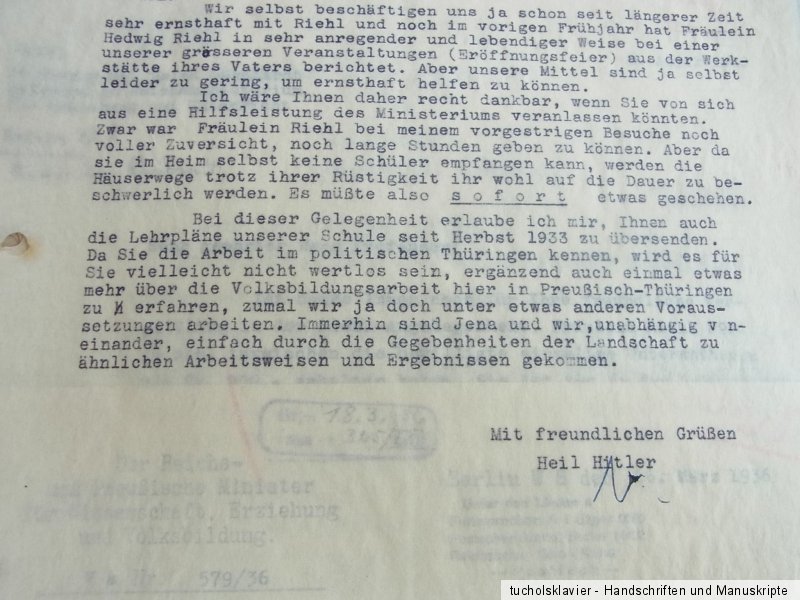

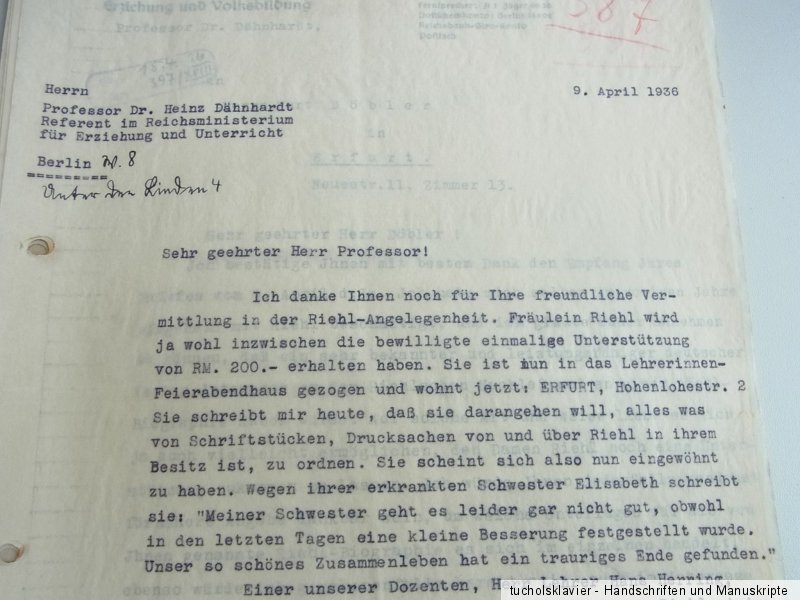
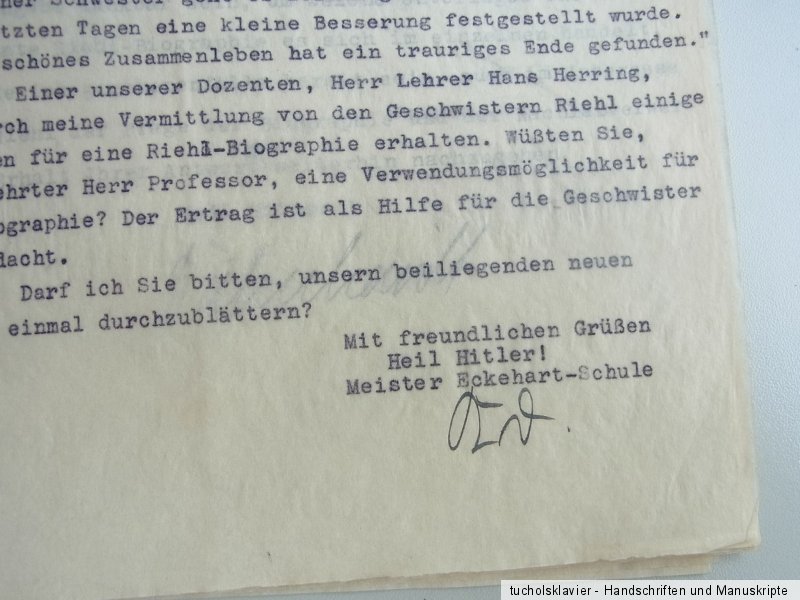


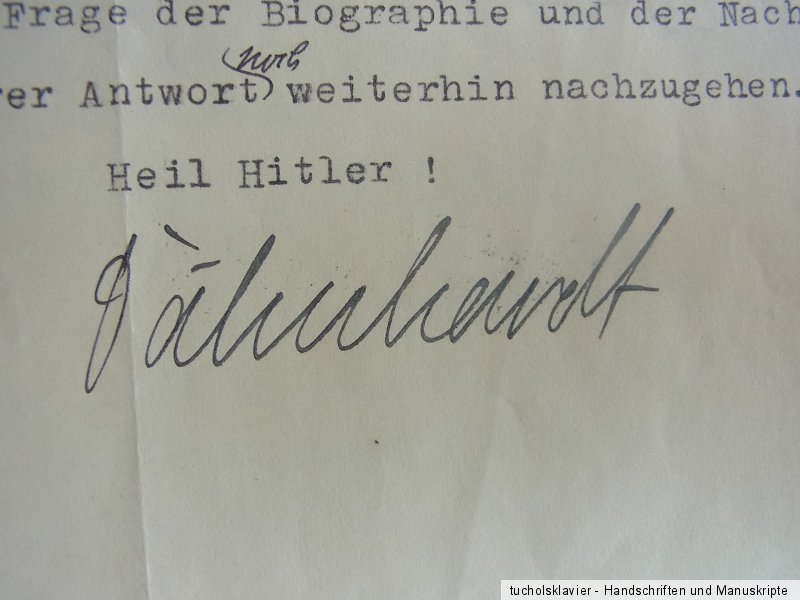
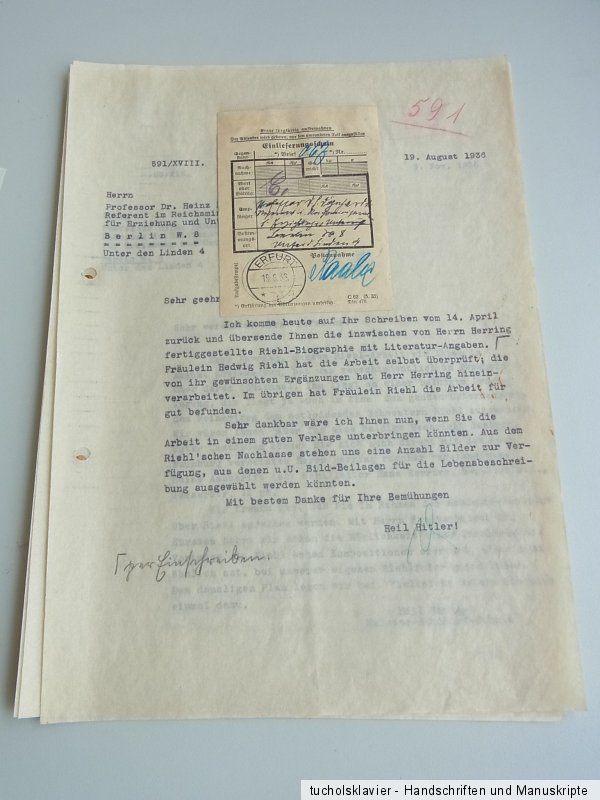
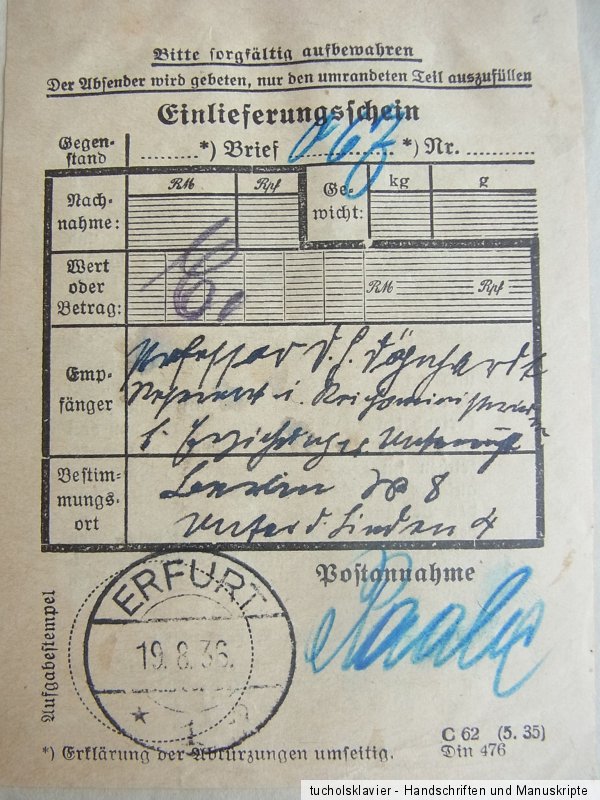
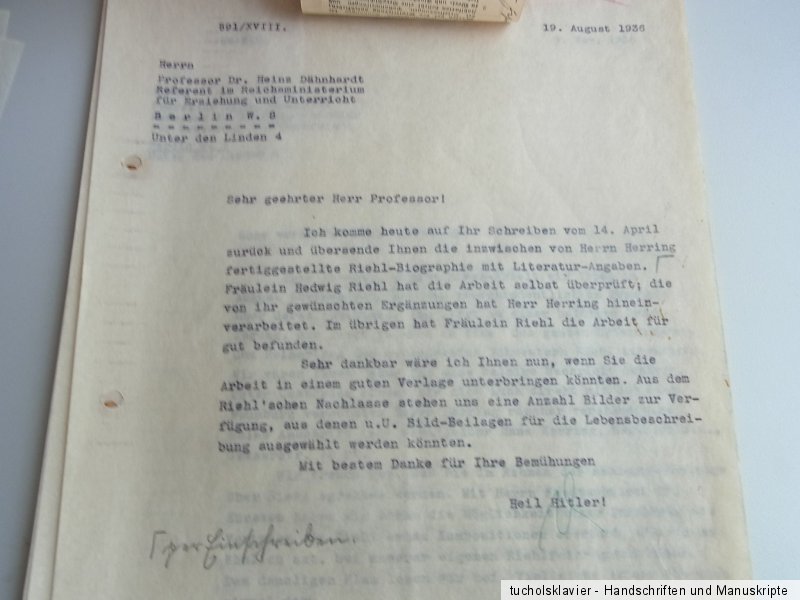
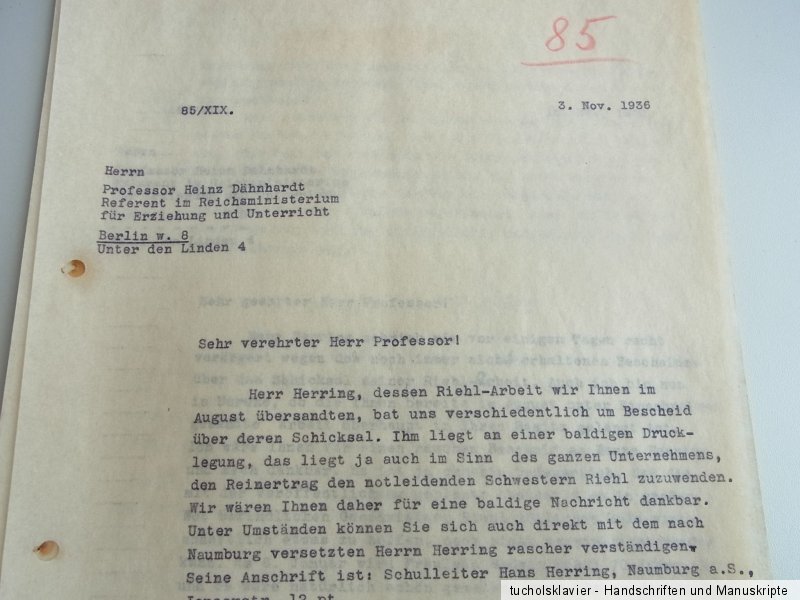



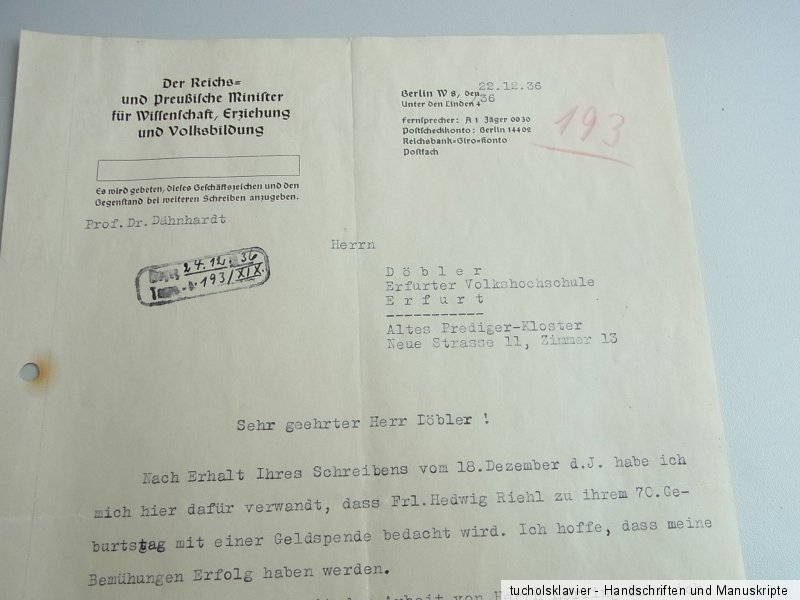





TRIXUM: Mobile-optimized auction templates and image hosting
About Heinz Dähnhardt and Wilhelm Heinrich Riehl (source: wikipedia):
John Heinrich Otto Viktor “Heinz” Dähnhardt (*14. July 1897 in Berlin-Wilmersdorf; † 30. October 1968 in Flensburg) was a German journalist, political multi-functionary in the Bund youth movement, lecturer in adult education, leading member of the Conservative People's Party and official in the National Socialist Ministry of Education.
Life
Participation in the World War, Freikorps and studies: The son of Vice Admiral Harald Heinrich Dähnhardt, a co-founder of the German Fatherland Party, attended the Municipal Werner-Siemens-Realgymnasium in Berlin-Schöneberg. He laid on the 8th. He graduated from high school in August 1914 and was employed as a war volunteer in the 5th Army from September 1914. Guard Regiment on foot deployed in East Prussia, Poland and Russia. In June 1915, he suffered a joint problem due to nerve paralysis, which led to permanent difficulty walking and thus to his discharge from the army.
At the beginning of the summer semester of 1915, Dähnhardt studied German and history at the University of Berlin. He also taught as a school assistant at his old school until September 1917. He was also involved in student self-government. He was a member of the German National Student Association and 1. Chairman of the General Student Committee of the University of Berlin. In September 1917 he was called up again on a trial basis and volunteered for the front in January 1918. He was released in January 1919 as a reserve deputy sergeant to his parents' residence in Altona.
In March 1919, Dähnhardt joined the Bahrenfeld Volunteer Guard Department as a temporary volunteer and was deployed to suppress revolutionary unrest in Hamburg in April and June 1919. Since August 1919, this volunteer corps was called the Greater Hamburg Temporary Volunteer Corps (“The Bahrenfelder”). On the 15th In March 1920 he joined the Reichswehr Brigade 9 in Schwerin under General Paul von Lettow-Vorbeck, which supported the Kapp Putsch. At the same time, he continued his studies at the University of Hamburg from April 1919, which he completed in February 1926. In 1927 he received his doctorate with a study on Joseph Görres' early political development (1776–1805) under Max Lenz.
Official of the Bund youth movement and the popular conservatives: As a student, Dähnhardt belonged to the German Scout Association. In 1919 he joined the German National Youth Association (DNJ) and the Young German Federation. In August 1921 he was one of the co-founders of the Young National League (Junabu), whose separation from the DNJ he played a key role in, and became its first federal leader. In 1922 he handed over the leadership of the Junabu to the national revolutionary Hans Ebeling, but took over the interim leadership again in 1924 when, after conflicts over the political orientation of the federal government, Ebeling split off part of the Junabu as an independent federal government.
Dähnhardt was close to the German National Trade Assistant Association (DHV). From May 1919 to May 1921 he worked as a member of the employment office of the Fichte Society of 1914 in Hamburg, which was financed by the DHV, in its popular education and youth work. He also published regularly in the DHV magazine Deutsches Volkstum. The Fichte Society of 1914 also founded its own “Fichte University” in 1916, which was financed by the DHV in Hamburg and spread the nationalist, anti-liberal, anti-Marxist and anti-capitalist ideas of this society. From 1926 to 1934, Dähnhardt was head of the Reich Office of the Fichte Society from 1914 and adult education officer at the Fichte School. In 1926 he transferred the headquarters of the association and the Fichte School to the Spandau Evangelical Johannesstift in Berlin.
Dähnhardt ran for the DNVP in the Reichstag and state elections in 1928. As executive chairman of the Christian Social Reich Association (since August 1929), he belonged to the Protestant workers' wing within the party. He played a key role in the spin-off of this wing of the DNVP and became general manager of the DNVP on 23. Conservative People's Party founded in June 1930. He had also been a member since February 1931 and since 5. June 1932 Spokesman of the leadership ring of the People's Conservative Association. From June 1932 to March 1933 he was chairman of the party, which was now called the People's Conservative Party.
From 1927 to 1932 Dähnhardt sat on the board of the Reich Committee of German Youth Associations. He was its first chairman since 1929. He published the magazines of Junabu, the Standard Bearer and the Young National Voices, and from 1930 to 31. March 1933 also the People's Conservative Voice.
Dähnhardt worked on a political network that Chancellor Kurt von Schleicher tried to establish in 1932. With the aim of a political “cross-front”, the Reichswehr Ministry sought close relationships with the youth movement and maintained a permanent connection to the Reich Committee of German Youth Associations, especially through Dähnhardt. At the beginning of October 1932, Schleicher's “young people” made contact with the left through the Reich Committee, which went through the managing director of the Reich Committee, the Social Democrat Hermann Maaß.
Ministerial official during National Socialism: On January 1st In May 1933, Dähnhardt joined the NSDAP and the SA. He became 1st. In April 1934 he was appointed provisional lecturer for historical education at the University of Teacher Training in Cottbus. From 1. On October 20, 1934, he was seconded to the Reich Ministry for Science, Education and National Education, where he was appointed on October 20th. August 1937 was appointed to the senior government council. Dähnhardt worked in the ministry as a specialist for adult education and public libraries; In 1938 he also became chairman of the Reich Examination Office for Libraries. In this role, he played a key role in shaping the guidelines of the National Socialist library system, which envisaged a “cleaning” of library holdings, followed by a uniform structure throughout the Reich in the spirit of Nazi cultural policy.[2]
Journalist and adult education employee: In April 1945, Dähnhardt fled from Berlin to Hamburg-Bergedorf. He was called a “follower” (cat. IV) was denazified and worked from 1948 to 1953 as a journalist and member of the editorial team at the Sonntagsblatt published by Hanns Lilje in Hamburg. When Hans Zehrer moved as editor-in-chief from the Sunday paper to the daily newspaper Die Welt, Dähnhardt briefly took over as editor-in-chief. Zehrer soon brought him in as head of the cultural department at Welt. From 28. October 1954 until his retirement on October 2nd. In February 1968, Dähnhardt was director of the Sankelmark Border Academy near Flensburg and headed the pedagogical office of the German Border Association.
In 1947, Dähnhardt played a key role in establishing the Free German Circle, a kind of rescue organization for former members of the youth movement of the Weimar Republic. Between 1962 and 1968 he was a member of the ZDF television council. From 1965 to 1968 he was also a member of the provost synod in Schleswig-Holstein. In 1968 he was awarded the Grand Cross of Merit of the Federal Republic of Germany.
Publications
Young national will and belief. Heinz Dietrich Wendland. Self-published by the (Young National) Federation (printed by the Hanseatic Publishing House), (Hamburg) (1921).
The Bahrenfelder. History of the Greater Hamburg Temporary Volunteer Corps in the years 1919/20. Alster, Hamburg 1925.
The young national movement. In: The new youth. Volume 1, 1927, pp. 46–56.
with Werner Pleister: The German speaking pipe. 2. edition. Hanseatic Publishing Company, Hamburg 1934.
The world of the book. A customer from the book. W. Langewiesche-Brandt, Ebenhausen near Munich 1942.
The public libraries in the total war of the nation. Radelli & Hille, Leipzig 1943.
Romance. [Lecture given in Loccum before the Free German Convention]., Loccum 1959.
What educational goal does youth association work have in modern society? Lecture. [Heinz Dähnhardt]. Schleswig-Holstein State Youth Association, Kiel 1959.
with Johannes Meyer and Gert Roßberg: Federal Republic of Germany currently. Wolff, Flensburg 1968.
Wilhelm Heinrich Riehl, from 1883 by Riehl (* 6. May 1823 in Biebrich; † 16. November 1897 in Munich) was a German journalist, novelist and cultural historian. In his works he emphasized social structures early on and thus gained influence on the development of folklore in the 19th century. Century, whose scientific founder he is considered.
Life: Wilhelm Heinrich Riehl was born in Biebrich as the son of the ducal Nassau castle administrator Friedrich August Riehl (1789–1839) and his wife Elisabeth Riehl (1793–1856). His father committed suicide in 1839. He first attended the Latin school in Wiesbaden, then the high school in Weilburg, where he passed his school leaving examination in 1841.
From 1841 to 1843 he studied theology in Marburg, Tübingen and Giessen. The motives for this study were his father's suicide and the poor financial situation. After passing his exams, he turned to philosophy, history and art history, which he studied in Bonn, among other places. Ernst Moritz Arndt was one of his academic teachers there. Under Arndt's influence, Riehl, who actually wanted to become a village priest after passing the theological candidate exam, decided to work as a freelance writer on cultural history and social politics.
He had been active as a writer and journalist since 1841. Topics such as economics, church politics and forestry and agriculture should also follow. Riehl wrote newspaper articles in Frankfurt am Main, Karlsruhe and Wiesbaden and published the Nassauische Allgemeine Zeitung from 1848 to 1851, while at the same time he was entrusted with the musical direction of the court theater in Wiesbaden. The Allgemeine Zeitung was a newspaper published on January 1st. Daily newspaper founded in April 1848 by the Nassau government to represent its positions. Riehl appears to have resigned from active participation at the end of April 1850. His successor was Alois Boczek, who set the paper on a course of political Catholicism. The resulting dispute with the Nassau government led to the 22nd August 1854 for the closure of the Nassauische Allgemeine Zeitung.
From 1851 to 1854 Riehl worked in Augsburg as editor of the local Allgemeine Zeitung.
In 1854 Maximilian II brought him. to the Munich court, where he was “chief editor for press affairs of the royal court. House and the Exterior” and received an honorary professorship at the Faculty of Economics, which was converted into a full professorship for cultural history and statistics in 1859. His lectures were among the best attended at the university. In 1861 he became a member of the Bavarian Academy of Sciences.
In 1883 Riehl was raised to the nobility. In 1885 he was appointed director of the Bavarian National Museum and general curator of Bavaria's art monuments and antiquities.
Family: Riehl married Bertha von Knoll (1824–1894) from Stuttgart in Eppstein (Taunus) in 1846; before her wedding she was a successful singer at the Frankfurt City Theater. The couple had five sons, one of whom died young, and four daughters, including:
Heinrich Karl (1852–1910), farmer in Oberföhring
Berthold (1858–1911), professor of art history at the University of Munich
Helene Christine (1848–1919), landscape painter ∞ Christian August Vogler (1841–1925), Dr. phil., professor at the Agricultural University in Berlin
Elisabeth Ida (1861–1937), teacher of language and music at the Neumayer Girls' Institute in Munich
Hedwig Antonie (1867–1947), violinist, music teacher in Erfurt.
After the death of his first wife, he married Antonie Eckardt († 1916) in Stuttgart in 1896. Riehl died in Munich at the age of 74.
Personal views: Riehl's academic interest was in the “morality” of the German people. Methodologically, it was groundbreaking: the researcher should explore his field. He was one of the first to scientifically address social and cultural historical issues. Among other things, he attempted to develop a “folk studies as a science” or to establish a “science of the people”.
His most famous work is The Natural History of the People as the Basis of a German Social Policy (4 volumes, 1851–1869), in which geographical factors, social conditions and German culture and way of life are emphasized. In the first volume, Land and People (1854), Riehl placed the national character of the European peoples in a direct relationship with the environment that surrounded them: characteristic landscapes of the English and French were the tamed park and the cleared field, the counterpart of which he found in the wilderness of the German forest saw. In the third volume, The Family (1855), he analyzed the family as the basis of all social developments and as the nucleus of society. The basic approach was his dichotomous view of gender: the difference “between woman and man” results, like a law, in “natural necessity” in the “uneven structure of civil and political society”.[1] Riehl was not only critical of urbanization in a time of industrialization, but even claimed that it was destroying families. Furthermore, the urban space should not displace “forest, pasture and water”, thereby attacking the influences on the condition of the landscape that accompanied the development of a civilized society far removed from nature. Riehl also saw urban areas as the “breeding ground for the socialist spirit of egalitarianism” as a result of the isolation of desperate individuals, which in turn was due to the destruction of families. Here his penchant for subjective generalizations and his conservatism become apparent.
However, Riehl did not oppose any developments from the cities. He stated that “inertia” in the social conservatism of the rural population and “movement” in the progressive attitude of the city dwellers were equally fundamental to society.
Significance: Due to his subject matter, Riehl is considered a pioneer or founder of, among other things, folklore, cultural history and sociology. Despite some subjective generalizations, his theories have been important for the development of Germany's cultural and social history. His descriptions of numerous, even remote, milieus (e.g. traveling theaters, rogues) are still valuable. However, his rejection of analytical procedures and “book scholarship” (19th century) century!), there was less schooling in favor of acquired experiences and literary expression; However, Girtler and Honer, among others, use this method in contemporary German-speaking cultural sociology.
Riehl is also considered one of the pioneers of nature conservation in the sense of protecting wilderness and not (only) cultural landscapes. In 1857, in addition to the “right of the field,” he called for the “right of the wilderness”: “For centuries it was a matter of progress to unilaterally represent the right of the field; Now, on the other hand, it is also a matter of progress to represent the law of the wilderness alongside the law of arable land. And no matter how much the economist resists and revolts against this fact, the people-researching social politician must still persevere and fight for the right of the wilderness.”[2] The successful development of a “people’s organism” does not only require the training of cultural ones peculiarity (cf. Herder), but also the preservation of wilderness as a reservoir of original, unalienated power that protects against the negative consequences of industrialization, urbanization, etc. protects, on the other hand, as a place of absence of social constraints and thus personal freedom, where people can become aware of their natural individuality, natural morality and individual self-responsibility.
However, Riehl is also considered one of the main pioneers of the legend of the patriarchal, idyllic extended family as a typical way of life of the pre-industrial era, which was only destroyed by the beginning of industrialization, but which, according to today's knowledge, did not exist in this form and distribution. In 1855, in the work The Family, Riehl appeared before the public for the first time with his family sociological program and thereby founded the legend of the pre-industrial extended family in the “whole house”, whereby he projected wishful ideas backwards into the past and then made these the basis of his 'findings' .
Honors: Riehl received the Order of Maximilian (1871), was appointed Privy Councilor (1889) and was awarded the Bavarian Order of Merit (1897). In Riehl's honor, a second educational institution, the Wilhelm-Heinrich-Riehl-Kolleg, founded as a foundation by the Düsseldorf Chamber of Crafts, was named after him in 1958.
Fonts
The story of Eisele and Beisele. Novel, 1848
The natural history of the people as the basis of German social policy, 1851–1869 [including numerous new editions]
1. Country and people, 1854
2. Civil society, 1851
3. The family, 1855
4. Hiking book, 1869
Musical character heads, 1853
Hausmusik, Fifty Songs of German Poets set to music by WHRiehl, 1855. [2. ed. 1860]
Cultural-historical novellas, 1856
The Palatinate. A Rhenish folk picture, 1857
Cultural studies from three centuries, 1859
German work, 1861
Stories from Old Times, 1863–1864
On the concept of civil society, lecture, 1864
New novella book, 1867
Gotthold Ephraim Lessing as a university friend, 1873
Free lectures, 1871 and 1885
Out of the corner. 7 new novellas, 1874
Neideck Castle, novella, 1875
At the end of the day. 6 new novellas, 1880
Life puzzles. 5 novellas, 1888
Cultural-historical character heads, 1891
Religious Studies of a World Child, 1894
A Whole Man, novel, 1897
Jörg Muckenbuber. In: German novella treasure. Ed. by Paul Heyse and Hermann Kurz. Vol. 8. 2. ed. Berlin, [1910], pp. 67–94. In: Weitin, Thomas (ed.): Fully digitized corpus. The German treasure of novellas. Darmstadt/Konstanz, 2016. (Digital copy and full text in the German Text Archive)